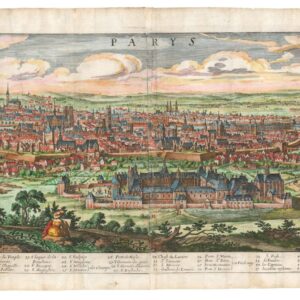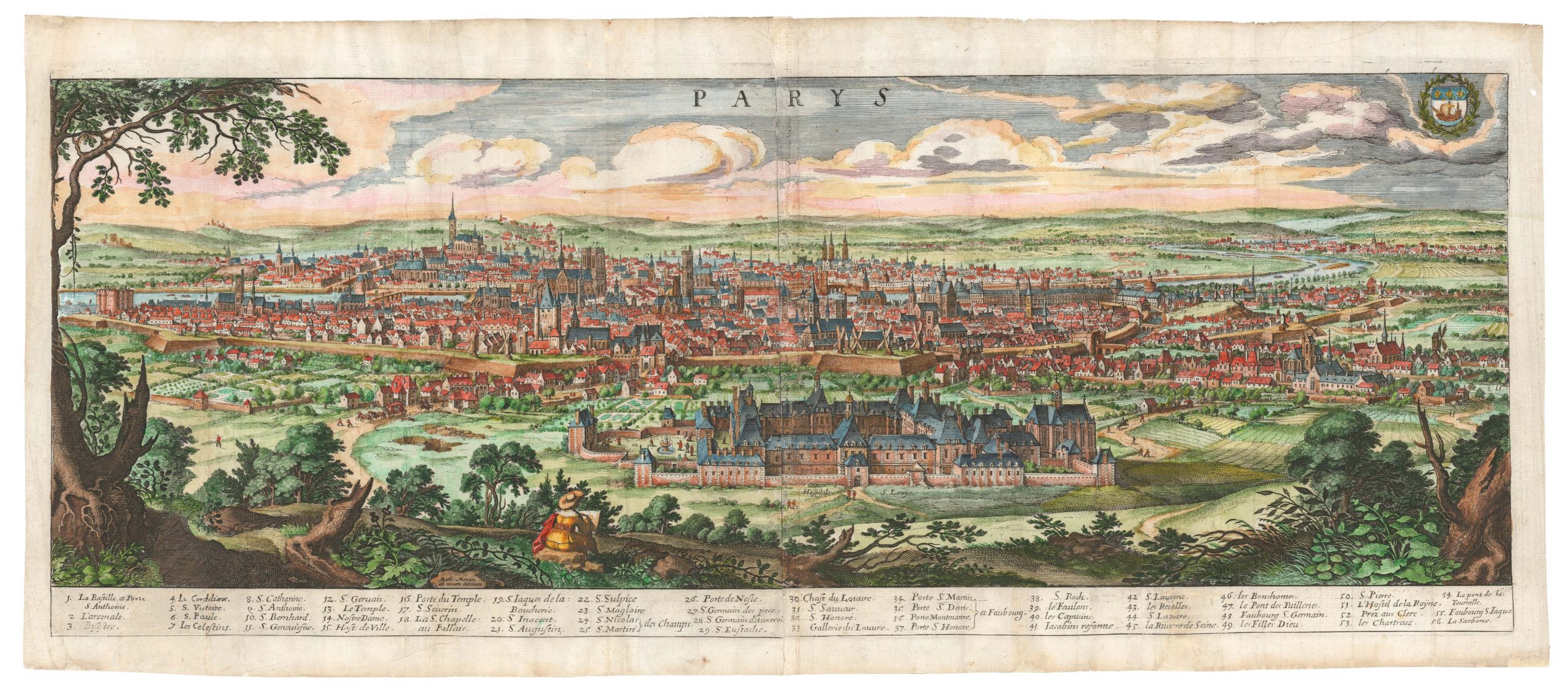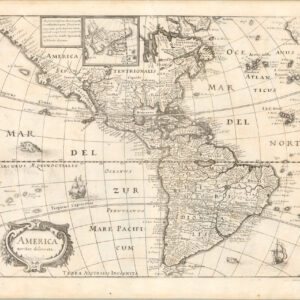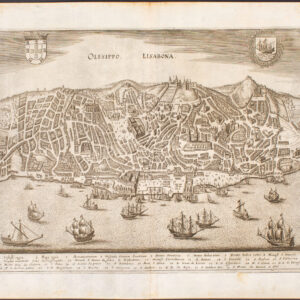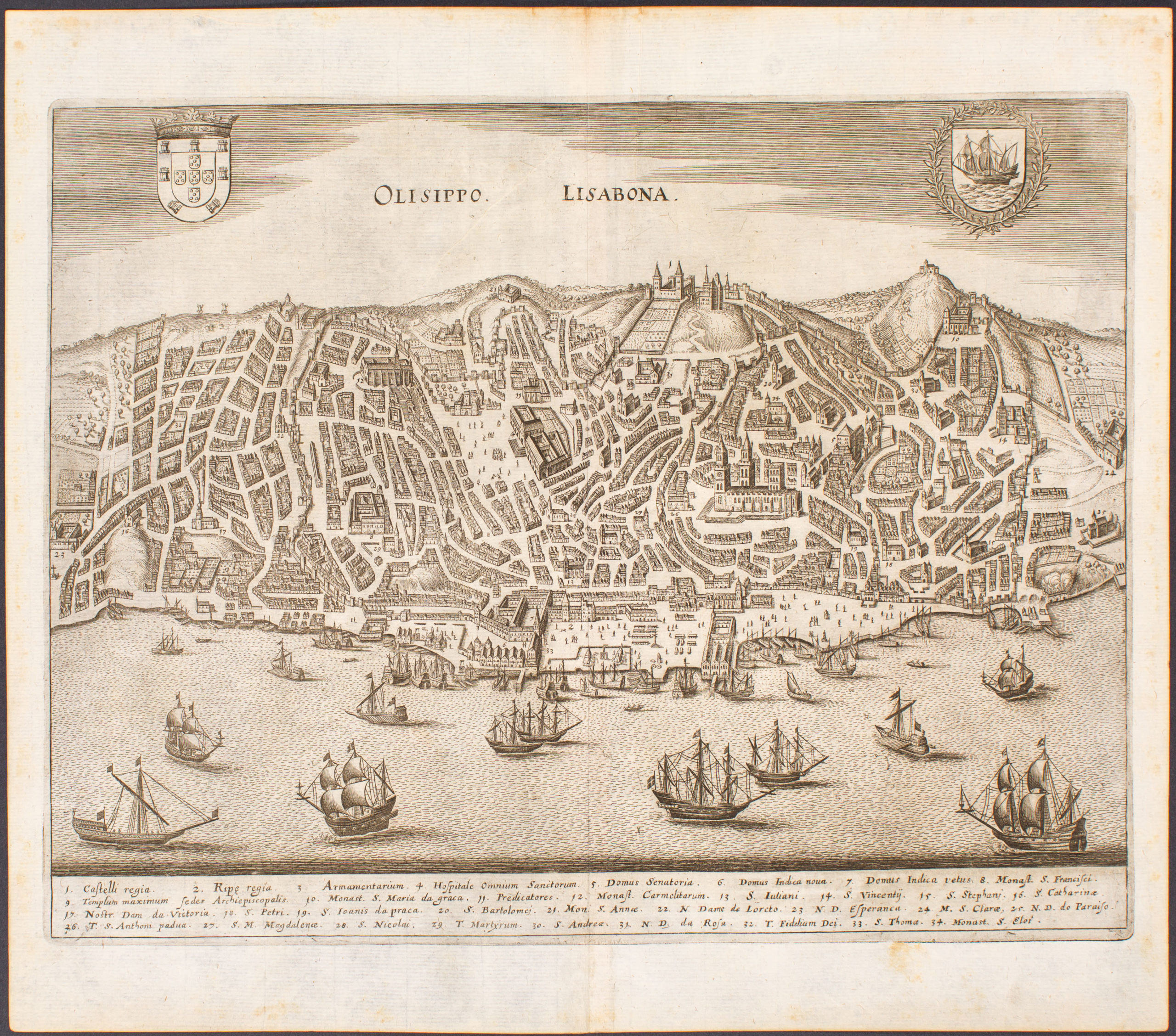Matthäus Merian (September 1593 – 19 June 1650) was a Swiss-born engraver who worked in Frankfurt for most of his career, where he also ran a publishing house. He was a member of the patrician Basel Merian family.
Early in his life, he had created detailed town plans in his own unique style, for example plans of both Basel and Paris (1615). With Martin Zeiler (1589 – 1661), a German geographer, and later (circa 1640) with his own son, Matthäus Merian produced a collection of topographic maps. The 21-volume set was collectively known as the Topographia Germaniae and included numerous town-plans and views, as well as maps of most countries and a world map. The work was so popular that it was re-issued in many editions. He also took over and completed the later parts and editions of the Grand Voyages and Petits Voyages, originally started by Theodor de Bry in 1590. Merian’s work inspired the Swedish royal cartographer, Erik Dahlberg, to produce his Suecia Antiqua et Hodierna, which became a cornerstone in European mapping.
After his death, his sons Matthäus Jr. and Caspar took over the publishing house. They continued publishing the Topographia Germaniae and the Theatrum Europaeum under the name ‘Merian Erben’ (i.e. Heirs of Merian). Today, the German travel magazine Merian is named after him.
-
-
Add to cartQuick View
- Asia
Xuntien alias Quinzay.
- $575
- Merian’s 1638 Bird’s Eye View of Hangzhou, China.
-
Add to cart
-
-
Add to cartQuick View
- Bird's-eye-views, Europe, Russia & Eastern Europe
[PRAGUE] Wahrhaffte Contrafactur der Weit Berühmbten Königlichen Haupt Statt Prag in Böhmen, Wie Solche Jetziger Zeit im Wesen Steht / Praga.
- $1,400
- Merian’s spectacular view of Prague still reeling from the Swedish invasion and thirty years of religious war.
-
Add to cart
-
-
Add to cartQuick View
- World
Nova Totius Terrarum Orbis Geographica Ac Hydrographica Tabula…
- $1,700
- Merian's endlessly fascinating 1646 world map.
-
Add to cart
-
-
Add to cartQuick View
- Bird's-eye-views, Europe, France & Switzerland
Parys.
- $1,500
- 1638 Merian panorama of Paris -- first plate with a self-portrait.
-
Add to cart
-
-
Add to cartQuick View
- Bird's-eye-views, Europe, Italy
Panormo.
- $650
- A superb late 17th century Merian town-plan of Palermo.
-
Add to cart
-
-
Add to cartQuick View
- Americas, Mexico - Central & South America, North America
America noviter delineata.
- $975
- An exciting classic.
-
Add to cart
-
-
Add to cartQuick View
- Asia, Southeast Asia & Australia
India Orientalis et Insulae Adiecentes.
- $875
- 1650 Merian map of Southeast Asia: a beautiful chart of one of the most important mercantile regions in the 17th century.
-
Add to cart
Archived
- Out of Stock

- Bird's-eye-views, Italy
Venetia.
- Merian’s spectacular bird’s-eye-view of Venice.
- Read moreQuick View
-
- Out of Stock
- Bird's-eye-views, Italy
Neapolis
- Finely-engraved 1640 bird's-eye-view of Naples.
- Read moreQuick View
-
- Out of Stock
- Bird's-eye-views, Italy
Venetia
- A spectacular 1641 Merian bird's-eye-view of Venice.
- Read moreQuick View
-
- Out of Stock
- North America
America noviter delineata
- 1631 Merian map of the Western Hemisphere with polar insets
- Read moreQuick View
-
- Out of Stock
- World
Nova Totius Terrarum Orbis Geographica ac Hydrographica Tabula
- Merian's 1646 world map with Gothic script and polar insets.
- Read moreQuick View
-
- Out of Stock
- Bird's-eye-views, Spain & Portugal
Olisippo Lisabona
- Nice 1635 bird's-eye-view of Lisbon.
- Read moreQuick View
-
- Out of Stock
- Spain & Portugal
Portugallia et Algarbia quae olim Lusitania
- Fine 1635 map of Portugal by Merian based on Portuguese sources
- Read moreQuick View
-

![[PRAGUE] Wahrhaffte Contrafactur der Weit Berühmbten Königlichen Haupt Statt Prag in Böhmen, Wie Solche Jetziger Zeit im Wesen Steht / Praga.](https://neatlinemaps.com/wp-content/uploads/2023/03/NL-01567_thumbnail-300x300.jpg)


